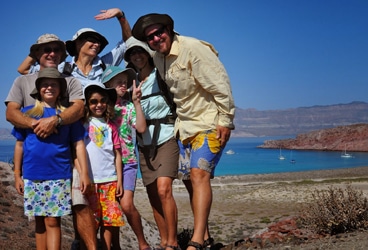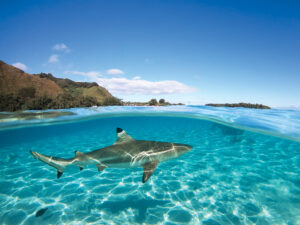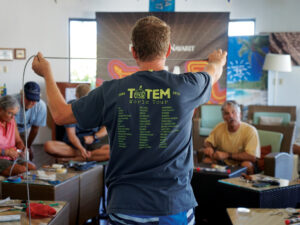
Del Viento is sitting high and dry and defenseless (against adverse weather) in a Sonoran desert boatyard. But more on that in a later post. I want to write today the story of our getting here, the story of our people.
We first met Ethan, Nancy, and their daughter Zada two years ago in La Paz. Afterward they sailed south on Eyoni to discover Panama while we headed north on Del Viento to discover Alaska. Now here we all were again, in this same city, the kids and parents picking up where we left off, but with a history. It was all good, except for what wasn’t.
The Eyoni crew were now at the disquieting intersection between their 6-year cruising past and a future that will look very different. While their return to stateside life is a fate we all share, for various reasons—and a personal reminder that we cannot forever delay our own return to the workaday world—it seems sort of unjust in Eyoni’s case. I’ve never met—nor even read about—a family that derives more joy from this floating vagabond existence.
When we left La Paz the first week of May, we left Eyoni behind. But the night before we raised anchor, over shots from Ethan’s tequila flask, Nancy said they may be right behind us, heading north for a short last hurrah in the Sea they’ve come to love. So we went slowly, just in case.
During our seven-day rendezvous, we saw more, explored more, and did more with the Eyoni-ans than we would have done in a month on our own. (We admit to letting days pass at beautiful anchorages where we hang out aboard just doing our thing.) Ethan and Nancy are keen observers and despite having spent seasons past in the Sea, they explore with a contagious sense of wonder, zeal, and appreciation that left us following in their footsteps, eager to have our eyes opened.
In a single day, we anchored in three different places, miles to sail between each of them. In that same day, we walked a beach as far as we could see, Nancy and Ethan helping us to identify the bones, shells, and tracks we encountered along the way. We climbed navigational lights, built a fire to roast marshmallows, and dinghied deep into mangroves for a picnic. We saw centuries-old hand tools hidden in plain sight among middens and we swam to the sandy bottom twenty feet below our boat to see the distinct shotgun-muzzle sign of buried clams. By the time we arrived at our evening anchorage at San Evaristo, Nancy had taught each of the three girls to braid their own Challah loaf for dinner.
Eyoni motoring into the sunset.
Eyoni is north now, way north, but out of the Sea, on the outside of the Baja, and not far from the U.S. border. I doubt assimilating back into U.S. life will be a painless affair, but I wish them the best. There are all kinds of families in this world, but only a tiny percentage of those who have the means and are otherwise able to be out here—living this unique, floating way—choose to do so. So the families we meet on this proverbial mountaintop, the ones who made the same set of choices we did, who face the same challenges, who yearn for and appreciate many of the same things, and who are as unabashedly pleased with their path after six years as we are after three years…well, those are our people.
Fair winds ashore Eyoni family. We’re spending the rest of the year in your beloved Sea and will refer often to the notes and superlatives that Ethan scribbled throughout our cruising guide.








